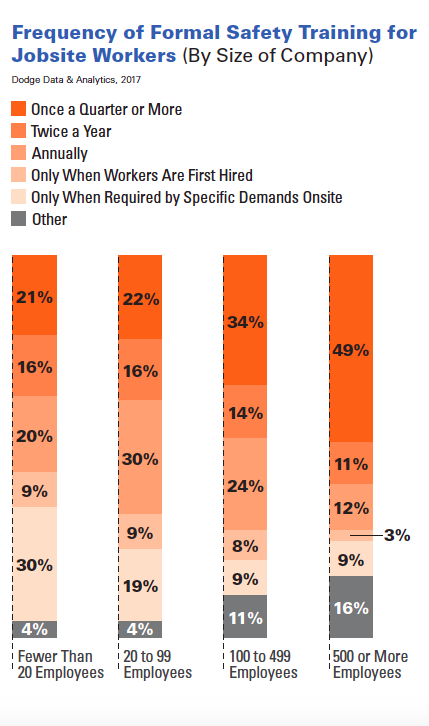You might be surprised by contractors’ number one pick.
In a 2017 Dodge SmartMarket Report on safety management in the construction industry, contractors were asked which of 12 factors they considered essential to a world-class safety program.
The #1 pick: Jobsite worker involvement
"Involving jobsite workers in the creation and implementation of a company’s safety program goes a long way toward getting them to buy into the value of the various safety practices. It can make the difference between workers feeling that policies have been forced on them and feeling that those policies exist for their own good and are worth following,” said James A. Dorris, vice president of health, safety and environment for United Rentals.
There’s another benefit to involving jobsite workers: These people are familiar with the work they’ll be performing and the hazards that go along with it, and they may therefore be able to offer some of the best insights on how to eliminate or mitigate those hazards.
According to Safety Management Group, getting workers involved in a company’s safety program can mean anything from seeking their opinions to asking them to serve on safety-related committees to inviting them to participate in site inspections and incident investigations.
After jobsite worker involvement, the aspects of a world-class safety program survey respondents chose most often were:
2. Strong safety leadership in supervisors
If your supervisors aren’t good safety role models, your safety policies don’t stand a chance of success. As OSHA put it, “Management leaders that demonstrate a personal commitment and genuine interest to safety can have a substantial impact on any organization.”
3. Regular safety meetings with jobsite workers and supervisors
Site-specific safety training is especially important and often includes orientation training and weekly jobsite safety meetings. Need winter toolbox talk ideas? Find some here.
4. Ongoing access to safety training for supervisors and jobsite workers
The survey found that most GCs (78 percent) offer safety and health training for workers and supervisors on 75 percent or more of their projects. Classroom training was deemed more valuable for supervisors than jobsite workers. Most GCs use an in-house trainer; about one-third hire a third-party trainer.
Not surprisingly, large companies offer training more frequently than smaller ones. Almost half of companies with 500 or more employees offer training at least once a quarter.

5. Hazard assessments and safety plans at each new jobsite
While 80 percent of the largest contractors deemed this aspect important, only 39 percent of the smallest ones did. It’s just one example of the gap between the safety programs and policies of large vs. small companies.
6. Strong emphasis on communication for company and project
In the survey, people in safety leadership positions were more likely to choose this factor as important to a world-class safety program. They also identified doing regular safety audits, prompt and thorough near-miss investigations, and having specific goals with associated metrics to measure.
According to a CPWR study, “A significant body of research suggests that frequent and open communication between supervisors and employees is associated with improved occupational safety, and that a supportive error management climate in the company – one in which supervisors encourage employees to use accidents and near-misses as opportunities for learning and improvement – can foster such communication.”
Safety doesn’t happen by accident. Companies that are serious about it plan for it and make it an ongoing priority.
Marianne Wait is an editor and writer who creates content for Fortune 500 brands.
Middle image credit: Dodge Safety & Analytics

